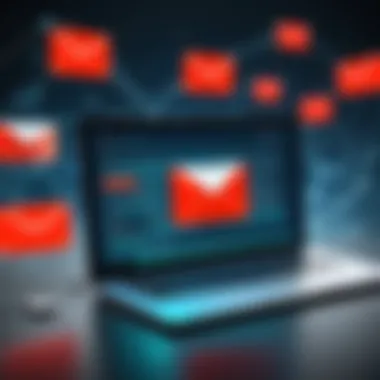Top DMARC Analyzers for Optimal Email Security


Intro
Email security is critical for businesses of all sizes in today’s digital landscape. One of the most effective protocols to enhance email security is Domain-based Message Authentication, Reporting, and Conformance (DMARC). DMARC plays a vital role in safeguarding against email spoofing and phishing attacks, which are common threats faced by organizations.
To fully leverage DMARC's capabilities, businesses often turn to DMARC analyzers. These tools provide insights and analytics that help organizations enforce their email authentication policies and maximize their DMARC benefits. This article aims to guide readers in exploring the best DMARC analyzers on the market, focusing on their features, functionalities, and implications for email security.
Understanding how these analyzers work is essential for IT professionals, business owners, and decision-makers who must navigate the complexities of digital communication security. The following sections will provide a thorough evaluation of the tools available, helping professionals make informed choices that align with their organizational needs.
Intro to DMARC
In today's digital environment, the significance of email communication cannot be overstated. Businesses rely heavily on email for both internal and external communication. However, this reliance also exposes them to various security threats, particularly email spoofing and phishing attacks. Domain-based Message Authentication, Reporting & Conformance (DMARC) has emerged as a crucial protocol designed to enhance email security by providing domain-level message authentication. This section aims to elucidate the concept of DMARC and its vital role in safeguarding email communications, thereby highlighting its relevance in business technology strategies.
Understanding DMARC
DMARC functions as an additional layer of protection on top of existing email authentication methods such as SPF (Sender Policy Framework) and DKIM (DomainKeys Identified Mail). The purpose of DMARC is to allow domain owners to specify how receiving email servers should handle non-authenticating email messages. This could mean rejecting, quarantining, or allowing the email based on the sender's policies. A correctly implemented DMARC record enhances the chances of legitimate emails reaching their intended recipients while minimizing the risk that fraudulent emails will be delivered.
The primary element of DMARC is its reporting function. When sending domains implement DMARC, they are empowered to receive feedback about how their emails are treated by recipient mail servers. This information can reveal unauthorized or malicious use of a domain, providing actionable insights. By understanding how DMARC operates, businesses can make informed decisions about their email authentication strategies.
Significance of DMARC in Email Security
The role of DMARC in email security cannot be overlooked. A well-structured DMARC policy stands as a robust defense mechanism against various email spoofing attempts. When you think about the potential consequences of not having DMARC in place, the risks become clear. Email spoofing can result in data breaches, financial losses, and a tarnished brand reputation. By implementing DMARC, organizations can not only protect their own reputation but also safeguard their customers and partners from falling victim to phishing attacks.
Furthermore, DMARC contributes to improved email deliverability. Many email providers, such as Google and Microsoft, use DMARC policies to determine whether an email should be accepted or blocked. A policy in place signals to these providers that the domain owner takes email security seriously, potentially leading to higher delivery rates for legitimate emails.
In summary, DMARC is not merely an additional layer of security, but a foundational practice for businesses aiming to enhance email integrity. Recognizing its importance equips businesses with the tools needed to adopt a more proactive stance in email security.
Challenges in Email Authentication
Email authentication remains a critical area of focus for organizations seeking to protect their communication channels. As cyber threats evolve, the challenges in this realm become more pronounced. Proper email authentication is vital to ensuring that legitimate emails reach their intended recipients while preventing fraudulent communications.
The complexities of email protocols and the existence of various standards can confuse even seasoned professionals. The lack of understanding of these challenges can lead to serious lapses in security. Consequently, organizations must prioritize comprehending these issues to fortify their defenses and enhance user trust in their email practices.
Common Threats: Spoofing and Phishing
Spoofing presents itself as a primary challenge in email security. This tactic involves a malicious actor posing as a trusted entity. Attackers use various methods to forge the sender's address, making it appear as if the email is coming from a legitimate source.
Phishing is a subset of spoofing, specifically designed to trick recipients into divulging sensitive information. These attacks typically utilize urgent messaging to create a false sense of urgency. For example, an email may claim to be from a bank, asking users to verify their account information due to suspicious activity. The goal is simple: to gather personal data such as passwords or credit card numbers.
Organizations and individuals alike must be vigilant against these threats. The implementation of DMARC, SPF, and DKIM can significantly mitigate these risks. However, ongoing education and awareness are equally important.
"The best defense against phishing and spoofing is a well-informed user base that understands the risks and signs of suspicious emails."
Consequences of Poor Email Authentication


The impact of inadequate email authentication can be severe. A single phishing attack can lead to financial loss, data breaches, and long-lasting damage to a brand's reputation. Organizations that neglect email security may find themselves facing regulatory penalties and loss of customer trust.
Some notable consequences of poor email authentication include:
- Financial loss due to fraudulent transactions.
- Costs associated with incident response and remediation efforts.
- Legal liabilities arising from data breaches.
- Damage to brand reputation, making it difficult to regain customer trust.
Ultimately, poor email authentication not only affects the organization directly involved but also poses risks to its customers and partners. Therefore, recognizing and addressing the challenges inherent in email authentication is essential for any business aiming to navigate today's digital landscape securely.
What is a DMARC Analyzer?
Understanding the role of a DMARC analyzer is crucial for anyone concerned about email security. A DMARC analyzer serves as a specialized tool designed to enhance the implementation of the DMARC (Domain-based Message Authentication, Reporting, and Conformance) protocol. This solution simplifies the complexities surrounding email authentication mechanisms and assists organizations in effectively managing their email domains.
Definition and Purpose
A DMARC analyzer allows organizations to monitor, analyze, and validate the email messages sent on their behalf. By establishing clear policies regarding how receiving mail servers should handle unauthenticated emails, organizations can significantly improve their overall security posture. The primary purpose of these tools is to provide valuable insights into email traffic, identifying unauthorized usage of domains and offering recommendations for rectifying vulnerabilities. This ensures that only legitimate senders can send emails from specific domains.
Key Features of DMARC Analyzers
DMARC analyzers come equipped with a variety of essential features designed to maximize their utility. Here are some of the most significant functionalities:
- Email Traffic Monitoring: This feature allows users to oversee all email activity associated with their domains. It identifies which sources are sending emails and whether they are compliant with DMARC policies.
- Reporting Capabilities: Comprehensive reporting tools provide critical data on DMARC performance, highlighting successful authentications as well as failures. This enables organizations to respond proactively to any issues.
- Policy Management: Many analyzers simplify the process of updating and managing DMARC policies, ensuring they align with current best practices and organizational needs.
- User-Friendly Interface: A straightforward user interface is essential in helping non-technical users navigate the complex information that these tools provide.
Implementing and utilizing a DMARC analyzer significantly contributes to enhancing email security strategies. It empowers organizations to not only safeguard their communications but also fosters trust with their customers and partners. Furthermore, incorporating such tools is increasingly recognized as a best practice in establishing a secure email environment.
"Effective monitoring and analysis is the cornerstone of successful DMARC implementation. Without a DMARC analyzer, gaining insights into email performance and security is a daunting challenge."
By adopting a DMARC analyzer, businesses can secure their email practices effectively while keeping pace with ever-evolving cyber threats.
Criteria for Evaluating DMARC Analyzers
Choosing the right DMARC analyzer is essential for organizations looking to enhance their email security. These tools enable users to implement DMARC effectively, minimize spoofing, and improve email deliverability. Evaluating them involves examining several criteria that influence usability, performance, and cost. Understanding these factors can help organizations make informed decisions, ensuring they choose a solution that aligns with their specific needs.
Usability and User Interface
Usability is a critical factor when evaluating DMARC analyzers. A user-friendly interface ensures that users, regardless of technical proficiency, can navigate the tool efficiently. The design should provide intuitive navigation, clear instructions, and a visually appealing layout. Tools that utilize dashboards for displaying key metrics and reports enhance the user experience by making complex data more accessible. Usability not only affects the learning curve for new users but also contributes to overall productivity in managing email security.
Reporting and Analytics Capabilities
Comprehensive reporting and analysis features are vital for understanding the performance of DMARC implementations. A capable DMARC analyzer should provide detailed reports that include insights into email authentication results over time. Features like visual graphs and trend analysis can be particularly useful in identifying potential issues. Furthermore, customizable reporting options allow businesses to focus on the metrics that are most relevant to their goals. Effective analytics help organizations refine their strategies and improve their overall email security posture.
Integration with Existing Systems
Integration capabilities are crucial when evaluating DMARC analyzers. Many organizations have existing systems or security protocols in place. A viable DMARC tool should seamlessly integrate with these systems, including email servers and other security platforms. This compatibility reduces complexity and enhances efficiency. Additionally, integration with services like Google Workspace or Microsoft 365 can streamline the authentication process, making it easier for organizations to manage their email security.
Cost Considerations


Cost is an inevitable concern when selecting any software, including DMARC analyzers. Pricing models can vary significantly between different tools. It is essential to consider not only the upfront cost but also ongoing expenses such as subscription fees, maintenance, and potential upgrades. Some analyzers may offer tiered pricing based on the size of an organization or the volume of email traffic. Understanding these cost structures can help businesses budget effectively while ensuring they receive the necessary features to protect their email communications.
Choosing the right DMARC analyzer requires careful evaluation of usability, reporting capabilities, integration options, and cost. Each of these factors significantly impacts the effectiveness of the tool in achieving desired email security outcomes.
Top DMARC Analyzers on the Market
The significance of selecting an appropriate DMARC analyzer cannot be overstated in the landscape of email security. As cyber threats escalate, businesses need tools that provide reliable data, intelligent insights, and user-friendly interfaces that facilitate the implementation and monitoring of DMARC policies. Each analyzer offers distinct features and benefits that can streamline the process of protecting email domains. Understanding the nuances between these tools allows professionals to choose the right solution that aligns with both their technical requirements and business goals.
Analyzer A: Features and Benefits
Analyzer A stands out due to its comprehensive features targeted at enhancing email authenticity. It offers robust reporting capabilities, allowing users to analyze incoming emails and identify potential threats. User-friendly dashboards present data in a clear manner, making it accessible even for those without extensive technical expertise. The tool also offers alert systems that notify users of suspicious email activities, ensuring proactive measures can be taken quickly. Additionally, Analyzer A integrates seamlessly with existing email systems, helping organizations adopt DMARC policies with minimal disruption.
Analyzer B: Advantages and Limitations
Analyzer B is praised for its depth in functionality, particularly its analytics for domain performance. This tool provides granular data on email streams, enabling businesses to track the effectiveness of their DMARC implementation. However, some users have pointed out limitations such as a steep learning curve. This complexity may deter smaller organizations with limited IT resources. Despite this, the advanced analysis and reporting capabilities can be invaluable for businesses with larger infrastructures that require detailed oversight.
Analyzer C: User Experiences
User experiences with Analyzer C tend to highlight its intuitive interface and strong customer support. Many users report that onboarding with this tool is smooth, with ample resources provided for training and assistance. The real-time feedback feature is often commended as it allows administrators to adjust policies based on immediate insights. That said, some users have mentioned minor glitches in data reporting under peak workloads. Overall, the majority feedback indicates that Analyzer C offers a reliable solution for many businesses seeking effective DMARC implementation without excessive complexity.
The Role of DMARC in Email Deliverability
The Domain-based Message Authentication, Reporting & Conformance (DMARC) protocol plays a pivotal role in ensuring the effective delivery of emails. As organizations increasingly rely on digital communication, the issue of email deliverability becomes critical. DMARC not only enhances security but also directly affects the chances of emails reaching end users. By employing DMARC, businesses can minimize instances of spoofing and impersonation, which are prevalent in today's email landscape. Secure email delivery leads to better engagement and trust from customers.
Impact on Deliverability Rates
Implementing DMARC can significantly improve email deliverability rates. When a DMARC policy is in place, receiving mail servers can authenticate the origin of emails, reducing the likelihood that legitimate emails are flagged as spam or rejected altogether. Research indicates that organizations utilizing DMARC observe improved inbox placement rates. Specifically, some studies suggest a boost of up to 10% in deliverability post-DMARC implementation. This increase is paramount for businesses that rely heavily on email marketing or communication with clients. High deliverability rates lead to higher visibility of marketing campaigns and ultimately better returns on investment.
"DMARC enhances not just security but also the effectiveness of email marketing strategies."
Best Practices for Implementing DMARC
A successful DMARC implementation involves several strategic measures. Businesses should follow these best practices:
- Start with a Monitoring Policy: Initially set up a ‘none’ policy to gather data on email flows without impacting delivery. Use this period to analyze reports.
- Use the Aggregate Reports: Leverage the feedback from aggregate reports to identify misconfigurations or unauthorized senders.
- Gradually Enforce Policies: Move from monitoring to stricter policies ( and then ) as confidence grows in the validation checks.
- Regularly Review Reports: Keep an eye on DMARC reports to stay updated on any anomalies or abuse.
Considerations for Small Businesses
Small businesses often face unique challenges when it comes to email security. The implementation of DMARC can seem daunting. It is vital for these enterprises to understand how DMARC analyzers can help enhance their security measures. Specifically, small businesses must prioritize cost-effective solutions and ensure scalability as their needs evolve. Addressing these considerations can significantly impact not only their security posture but also their overall operational resilience.
Cost-Effective Solutions
Cost is a major concern for small businesses. Many solutions on the market can be expensive, posing a hurdle. Thus, small firms need to identify cost-effective DMARC analyzers. These tools should provide essential functionalities without overextending the budget. A few points to consider include:


- Subscription Models: Opt for analyzers that offer flexible subscription plans. Some may provide pay-as-you-go options or tiered pricing, allowing for better alignment with cash flow.
- Free Trials: Take advantage of free trials offered by various analyzers. This can provide insights without immediate financial commitment.
- Return on Investment (ROI): Analyzing potential ROI is crucial. Ideally, an effective DMARC solution will reduce instances of phishing and spoofing, ultimately saving money on potential recovery and reputation management.
These approaches can help small businesses prioritize their spendings while ensuring robust email security.
Scalability of DMARC Solutions
As businesses grow, their needs change. The scalability of DMARC solutions is critical for small businesses. When evaluating analyzers, it’s important to consider whether the solution can adapt to increased volumes of email traffic or more complex security requirements over time. Key aspects include:
- Flexible Configurations: Check whether the solutions provide easy adjustments for evolving policies as the business scales. This could involve changing reporting parameters or dedicated user roles.
- Multi-Domain Support: Many small businesses start with a single domain. It is essential to select a DMARC analyzer that supports multiple domains, especially when expansion is planned.
- Integration Capabilities: Finally, ensure that the chosen tool can integrate smoothly with existing email systems or other security measures. Integration facilitates a more comprehensive security strategy, accommodating growth without significant additional effort.
"Implementing DMARC correctly not only secures an organization's email but also builds customer trust."
Future Trends in DMARC Analysis
The realm of email security is evolving rapidly due to increased threats and the demand for more sophisticated defense mechanisms. Future trends in DMARC analysis will shape how organizations implement DMARC policies and manage email authentication. As the threat landscape changes, businesses will need to adapt their strategies. The upcoming trends promise improvements in user experience, analytical capabilities, and adaptability. Understanding these trends is crucial for IT professionals and decision-makers aiming to strengthen email security measures.
Emerging Technologies
Emerging technologies are reshaping DMARC analysis. One significant development is the integration of artificial intelligence and machine learning into DMARC analyzers. These technologies can analyze large volumes of data to detect anomalies in real-time. AI-driven tools can identify patterns that suggest malicious intent, providing more proactive defense against email spoofing and phishing. The analysis becomes more intuitive, enabling the identification not just of breaches but trends that lead to vulnerabilities.
Blockchain is another technology that may enhance DMARC analysis. It offers a secure way to verify email legitimacy without relying solely on traditional methods. By using decentralized verification, organizations can create tamper-proof records of email authenticity. This could significantly reduce the chances of email spoofing, as alterations would be easily detectable.
Additionally, cloud-based solutions are becoming integral to DMARC tools. Such solutions ensure scalability and flexibility, allowing businesses to adapt to changing needs without significant infrastructure changes. The ongoing enhancement of user interfaces will make it easier for users to manage their DMARC settings and analyze email reports.
Predictions for Email Security Landscape
Looking ahead, the email security landscape is expected to become more sophisticated. As spammers and attackers refine their techniques, DMARC policies will evolve to address these challenges. One prediction is the standardization of email authentication practices across industries. This could lead to greater cooperation among businesses to share threat intelligence and enhance collective defenses.
Moreover, increased regulation around email security can be anticipated. Governments may impose stricter compliance requirements for organizations regarding their email authentication measures. This can prompt more organizations to prioritize DMARC implementation and enhance their overall security posture.
As the emphasis on user privacy continues to grow, DMARC will be part of a larger strategy that includes privacy-focused measures. Organizations will likely need to balance user data protection with the need for effective email authentication. This will drive the search for solutions that are both secure and respectful of privacy concerns.
Overall, these trends suggest a more integrated and intelligent approach to DMARC analysis. Organizations that stay ahead of these trends are more likely to maintain their integrity in email communications and establish trust with their clients. In this fast-evolving environment, being proactive in adopting emerging tools and anticipating future developments will be critical for sustaining robust email security.
The End
The conclusion of this article serves as a pivotal juncture, synthesizing the preceding discussions on DMARC analyzers and their critical role in email security. Understanding how these tools function and their importance assures businesses they take the necessary steps to safeguard their communications. In today's threat landscape, where email remains one of the primary vectors for cyber attacks, the effective use of DMARC is indispensable.
Recap of Key Points
To reiterate, DMARC analyzers provide invaluable insights into email authentication processes, allowing organizations to mitigate risks associated with spoofing and phishing. Key takeaways include:
- DMARC Fundamentals: DMARC operates by providing a mechanism for domain owners to control email authentication, improving trustworthiness of their communications.
- Key Features: Features of DMARC analyzers, such as reporting capabilities, user-friendly interfaces, and integration options, enhance their utility.
- Market Analysis: Various DMARC tools are available, each with unique advantages, limitations, and pricing structures. Evaluating them on usability and reporting standards is vital to making informed choices.
- Future Trends: The development of emerging technologies will shape the future of email security and DMARC implementations, making staying informed essential.
Final Recommendations
As organizations consider adopting DMARC analyzers, a few recommendations emerge:
- Assess Needs: Identify your organization's specific email security requirements and choose a DMARC tool that aligns with those needs.
- Trial Periods: Utilize trial versions whenever available to gauge functionality and support ahead of commitment.
- Regular Updates: Stay informed about updates and advancements in DMARC technology to maintain robust email security.
- Engage Experts: Periodically consult with cybersecurity experts to re-evaluate the effectiveness and appropriateness of your chosen solution.
Ultimately, investing in a DMARC analyzer is an essential step in enhancing email security and maintaining the integrity of communications. The decisions made today will have lasting impacts on managing potential risks, thus fostering a secure email environment.







